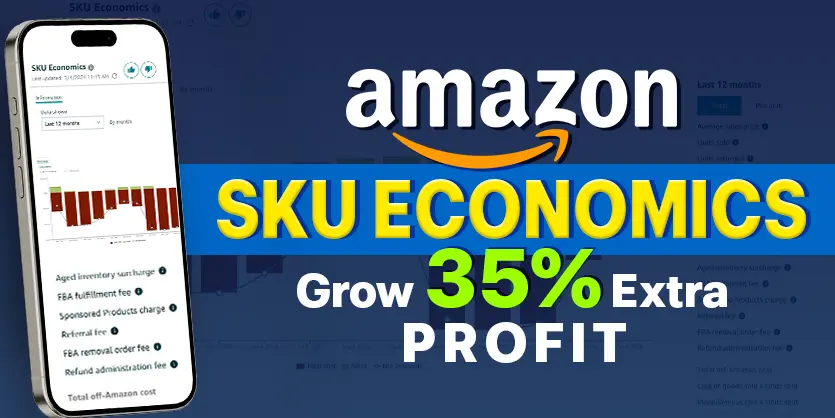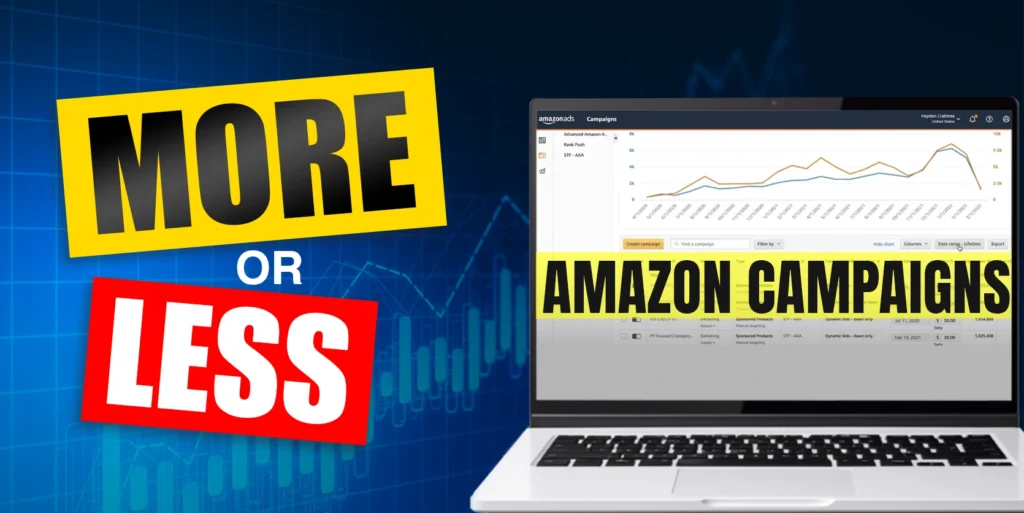As an Amazon seller, achieving strong sales and maintaining a decent TACoS (Total Advertising Cost of Sale) is a significant achievement. However, even with impressive performance metrics on your dashboard, you might still doubt that are you truly generating enough profit. To make your business more profitable, it’s obvious to understand the financial health of each product available in the inventory. The Amazon SKU Economics Report is a valuable tool for this purpose. It provides a detailed breakdown of expenses and helps identify which products are performing well and which need improvement. In this guide, we will walk you through the key features of the Amazon SKU Economics Report, how to generate it, and how to use its insights to adjust your PPC campaigns for better results.
In this article, we will discuss:
- What is the Amazon SKU Economics Report
- Key Features of the Amazon SKU Economics Report
- Benefits of the Amazon SKU Economics Report
- How to Generate SKU Economics Report on Amazon
- Organization & Explanation of Columns and Data of SKU Economics Report
- How to Adjust PPC Campaigns with SKU Economics Report
1. What is the Amazon SKU Economics Report
The Amazon SKU Economics Report is a comprehensive tool provided by Amazon to help sellers. It evaluates the financial performance of their products or SKUs. It gives sellers a breakdown of costs associated with each item, including Amazon fees, fulfillment, shipping, and storage costs.
The Amazon SKU Economics Report report is designed to provide valuable insights into the profitability of products. It allows sellers to make informed decisions about pricing, inventory management, and overall business strategy. By analyzing this data, sellers can optimize their operations to improve profitability and efficiency on the Amazon platform.
2. Key Features of the Amazon SKU Economics Report
- The Amazon SKU economics report shows Amazon fees, shipping, fulfillment, and storage costs for each SKU.
- It shows net profit or loss for individual products, helping sellers assess financial performance.
- You will get sales performance data for your business. It will provide metrics like units sold, revenue generated, and other key sales figures.
- It highlights all Amazon-related fees such as referral fees, FBA fees, and variable closing fees.
- You can get data to optimize stock levels, reducing overstocking or understocking issues.
3. Benefits of the Amazon SKU Economics Report
Amazon SKU Economics Report offers several benefits for sellers, such as driving smarter business decisions and enhancing profitability. Here, a few of them are given below:
- The Amazon SKU Economics Report provides a clear view of the costs and profits for each SKU, enabling better pricing and product strategies to maximize profits.
- With these detailed financial insights, it can help sellers make data-driven decisions about inventory, pricing, and promotions.
- It shows the high-cost areas like shipping or fulfillment fees that allow sellers to optimize logistics and reduce expenses.
- Sellers avoid overstocking or understocking by utilizing the Amazon SKU Economics Report data.
- The seller can manage all relevant fees in a more organized way.
4. How to Generate SKU Economics Report on Amazon
To generate and download the Amazon SKU Economics Report, first log in to your Amazon Seller Central account and navigate to the “Reports” tab from the menu bar. Then click on the “SKU Economics Report” option.
Next, configure the report parameters by choosing the marketplace, data aggregation level, and date range. In the report configurations, specify the data you need, including sales data, PPC data, advertising spend, off-Amazon costs, storage fees, fulfillment base rate, surcharge, and net proceeds.
You can also add any additional columns if necessary. Then click on the “Generate Report” option to create your customized report. Once it’s generated, download it from the “Reports” section and open the file to review the aggregated data on fees, costs, and net proceeds for your SKUs.
You will find numerous important metrics with various columns in the SKU Economics Report. The report features data such as the Amazon store start date, end date, parent ASIN, child ASIN, FNSKU, MSKU, and currency.
5. Explanation of SKU Economics Report
To make the report more manageable, firstly you will need to organize it and remove any unnecessary columns. Here’s how the report is structured after this organization. This section outlines the key sales metrics, including the average sales price, units sold, and returns. It provides a clear picture of net units sold and both gross and net sales revenue.
- Average Sales Price: The average sales price for each ASIN.
- Units Sold: The number of units sold for each individual ASIN.
- Units Returned: The quantity of units returned for each ASIN.
- Net Units Sold: The number of units sold after returns are accounted for.
- Net Sales: The total sales revenue after deducting returns.
- Total Sales: The gross sales revenue before returns are deducted.
Here, we will see various fees related to inventory, fulfillment, and advertising, culminating in the net profit total. It helps you understand the costs involved and how they impact overall profitability. By analyzing SKU economics, you can identify the most profitable products, optimize pricing, and reduce unnecessary costs, thereby improving your overall margin and business efficiency.
- Inventory Surcharges: Additional fees for aged inventory. ASINs with inventory older than 180 days incur extra charges.
- Base Fulfillment Fee: Standard fee for fulfilling orders.
- Base Monthly Storage Fee: Charges for storing inventory in Amazon’s warehouses.
- AA Disposal Order Fee: Fees for disposing of excess or aged inventory.
- FBA Fulfillment Fee: Charges for using Amazon’s Fulfillment by Amazon (FBA) services.
- FBA Inbound Placement Service Fee: Costs related to placing inventory into Amazon’s fulfillment centers.
- Inbound Transportation Charge: Fees for shipping inventory to Amazon’s warehouses.
- Managing Inventory Storage Fee: Additional fees for managing inventory storage.
- Referral Fee: Commission charged by Amazon on each sale.
- Refund Fee: Costs associated with processing refunds.
- Sponsored Products Ad Fee: Advertising costs for sponsored product listings.
- Cost of Goods Sold per Unit: This column is blank as Amazon does not have information on your specific cost of goods.
- Miscellaneous Cost per Unit: Includes any additional costs not covered in other columns.
- Finally, the Net Profit Total is calculated after deducting all the listed costs from the net sales.
By understanding these elements, you can effectively analyze your SKU performance and associated costs to make more informed business decisions. This organized view helps to clearly understand the sales performance and financial metrics of each SKU. And the net sales reflecting the revenue after returns have been considered.
6. Adjust PPC Campaigns with SKU Economics Report
To adjust your PPC campaigns based on insights from the SKU Economics Report, follow these steps:
Review Profit Margins: You need to start by examining the profit margins for each ASIN from the SKU Economics Report. Then, identify which products have negative or low margins after accounting for all costs.
Analyze Cost Drivers: For ASINs with poor margins, review the specific costs impacting profitability. The High Base Fulfillment Fees can erode your margins significantly, and the High Inbound Transportation Charges can reduce profitability.
Adjust PPC Bids: For products with low or negative margins, you can lower your PPC bids. For these particular ASINs, you need to decrease the cost of advertising and improve overall profitability. You have to consider pausing or limiting PPC campaigns for ASINs with consistently negative margins to avoid further losses.
Refine Targeting: Your targeting strategies should be based on the performance data. If you are capable of more budget for PPC campaigns, you should increase the budget for products with higher profit margins.
Optimize Ad Spend: You have to ensure your Advertising Cost of Sale (ACOS) is in line with your profit margins. High ACOS may indicate that your advertising spend is too high relative to the revenue generated. You need to reallocate budgets from low-margin ASINs to high-margin ASINs to optimize your overall ad spend.
If you can utilize the insights from the SKU Economics Report, you can make informed decisions to enhance your PPC campaigns, optimize ad spend, and improve overall profitability.
Conclusion!
The Amazon SKU Economics Report provides a comprehensive view of your product costs, fees, and profits, allowing you to make well-informed decisions. By carefully analyzing this report, you can know the hidden expenses, optimize your inventory management, and refine your PPC campaigns to maximize profitability. Understanding the financial performance of each SKU helps you avoid costly mistakes. It ensures that your advertising strategies align with your profit goals.
Here, at Ecomclips, we have been helping many Amazon sellers boost their sales and capture market share with both PPC and organic SEO. If you need any help boosting your Amazon sales or growing your brand, please don’t hesitate to mail us at our email address, info@ecomclips.com
Also, if you require an Amazon store or account audit for both PPC ads and SEO, you can let us know via our email address, and we will provide you with a free account audit. Additionally, if you require any assistance, please reach out to us in the comment box. We are here to assist you in managing PPC advertisements to improve your profit, so we offer a personalized approach to our service.



